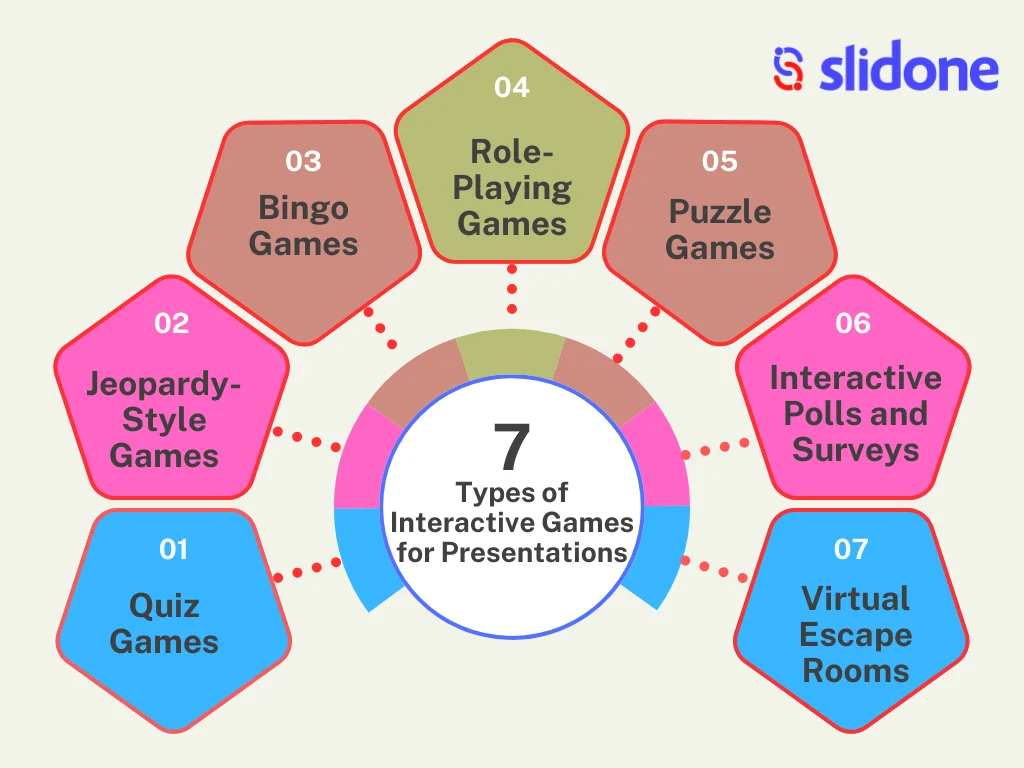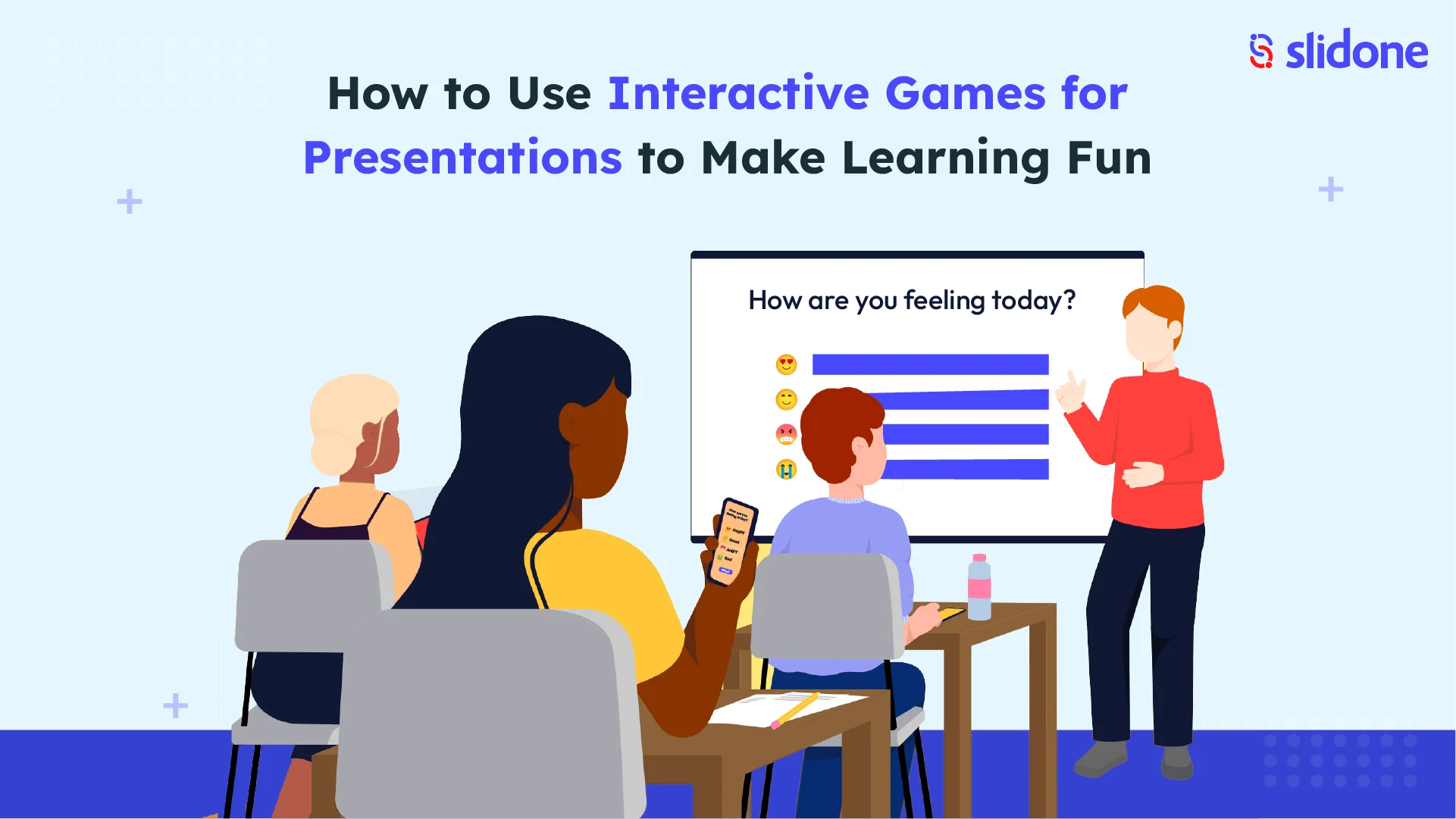Adding interactive games to your presentations can make learning fun and exciting. Games bring a new level of engagement that helps people remember information better and stay motivated. This blog will show you how to use games in your presentations to make learning more enjoyable. By including games, you can make your sessions more lively and keep your audience interested. Learn simple ways to incorporate games into your next presentation and see how they can make a big difference in how your audience experiences your content.
Understanding the Value of Interactive Games
Interactive games in presentations are not just about fun; they offer several educational benefits:
1. Enhanced Engagement
Games grab people’s attention and make learning more fun. When people are actively playing, they stay more focused and interested. Using games in learning helps keep everyone involved and excited. This approach makes it easier to remember and enjoy the material. By adding games, the whole process becomes more interactive and lively, encouraging participation. As a result, people are more likely to stay engaged and absorb the information better. Overall, games turn learning into an enjoyable experience, keeping participants motivated and attentive.
2. Improved Retention
Learning through games helps strengthen important ideas and information. When we play games, we connect what we learn with fun activities, which makes it easier to remember. Games make learning more enjoyable and memorable by linking new knowledge with playful experiences. This method not only makes studying more fun but also helps keep the information fresh in our minds. By using games as a learning tool, we can better remember and understand key concepts. So, adding games to learning can be a great way to make information stick.
3. Increased Participation
Games help everyone join in, even those who might feel shy in a regular setting. This friendly approach makes it easier for everyone to work together and learn from each other. By including fun activities, people feel more comfortable and are more likely to share their ideas. This way, everyone can be involved and contribute to the group’s success. It creates a positive atmosphere where collaboration and learning thrive, making the whole experience enjoyable and effective for everyone.
4. Real-Time Feedback
Games give instant feedback, letting players see what they’re good at and where they need to improve right away. This quick response helps players learn more effectively and start conversations about what they’ve learned. By showing results immediately, games make it easier for players to adjust their strategies and focus on areas that need more practice. This kind of feedback makes learning more interactive and engaging, helping players understand their progress and make the most of their experiences. Overall, the immediate feedback from games supports better learning and more meaningful discussions.
Types of Interactive Games for Presentations

1. Quiz Games
How to Implement
Using quiz games is a great way to test knowledge and review material. With tools like Slidone, you can easily create and run quizzes, and see live results. This method makes learning fun and interactive, helping everyone stay engaged and understand the material better. By using quizzes, you can quickly check what people know and where they might need more practice. It’s a simple and effective way to make sure everyone gets the most out of their learning experience.
Benefits
- Engagement: Quizzes make learning interactive and competitive.
- Assessment: Provides immediate insight into participants’ understanding.
Tips
- Create questions that are relevant to your content.
- Keep quizzes short to maintain interest and avoid overwhelming participants.
2. Jeopardy-Style Games
How to Implement
Create a Jeopardy-style game by choosing categories related to your presentation topic. Use tools like JeopardyLabs or PowerPoint templates to set it up. For instance, if your topic is about interactive presentations, your categories could be “Types of Interactive Slides,” “Best Practices,” “Engagement Tips,” “Tools for Interaction,” and “Case Studies.” Each category can have questions of varying difficulty and point values. This format helps make your presentation more engaging and interactive, allowing your audience to actively participate and test their knowledge on the subject.
Benefits
- Organized Learning: Allows you to cover different topics in a structured way.
- Competition: Adds a competitive element that can motivate participants.
Tips
- Ensure questions vary in difficulty to cater to different knowledge levels.
- Provide clear instructions on how to play the game.
3. Bingo Games
How to Implement
Create Bingo cards with important words or ideas from your presentation. As you talk about each term, participants can mark it off on their cards. This keeps everyone engaged and helps them focus on the key points. To make it more fun, you can give a small prize to the first person who gets a Bingo. This activity makes your presentation more interactive and memorable, ensuring that important concepts are understood and remembered. It’s a simple way to keep your audience interested and involved throughout your presentation.
Benefits
- Active Listening: Encourages participants to pay attention to key points.
- Fun and Simple: Easy to set up and play, making it suitable for all ages.
Tips
- Customize Bingo cards to align with your presentation content.
- Offer small rewards to increase motivation.
4. Role-Playing Games
How to Implement
Use role-playing activities to make your presentation more engaging. Have participants act out different scenarios that relate to the topic of your presentation. You can do this in small groups or pairs. This approach helps people understand the material better and stay involved. By practicing real-life situations, they get to experience the topic firsthand. It also makes the presentation more interactive and memorable. Role-playing encourages participants to think critically and apply what they’ve learned in a fun and practical way.
Benefits
- Real-Life Application: Helps participants apply concepts in a practical context.
- Collaboration: Promotes teamwork and communication skills.
Tips
- Clearly define the roles and scenarios.
- Facilitate a debriefing session to discuss what was learned.
5. Puzzle Games
How to Implement
Try using puzzles like crossword puzzles or jigsaw puzzles to make your presentation more engaging. You can use tools like Puzzle Maker or online crossword makers to create these fun games. These puzzles can be themed around your presentation topic, making them a great way to keep your audience interested. They also add an interactive element, which can help with learning and retention. Plus, puzzles can be a fun break from traditional presentation formats and encourage active participation from your audience.
Benefits
- Critical Thinking: Encourages problem-solving and critical thinking skills.
- Engagement: Provides a fun way to review and reinforce learning.
Tips
- Ensure puzzles are challenging but not too difficult.
- Provide hints or clues to help participants if they get stuck.
6. Interactive Polls and Surveys
How to Implement
During your presentation, consider using live polls or surveys to gather opinions or test knowledge. Tools like Slidone are great for this because they offer all the features you need to make your presentation interactive. By using these tools, you can engage your audience more effectively and get instant feedback on various topics. This approach not only makes your presentation more engaging but also helps you understand your audience better. Whether you’re looking to check understanding or get opinions, live polls and surveys can make your presentation more dynamic and valuable.
Benefits
- Instant Feedback: Provides real-time insights into participants’ views.
- Involvement: Encourages everyone to share their opinions and participate.
Tips
- Use polls to spark discussion or gauge understanding.
- Keep questions clear and relevant to your presentation content.
7. Virtual Escape Rooms
How to Implement
Create a virtual escape room with fun challenges and puzzles based on your topic. Use tools like Escape Room Maker or Google Forms to build it. Start by designing a storyline that fits your theme. Include various puzzles such as riddles, matching games, and logic questions. You can also add interactive elements like clickable clues or hidden codes. Make sure each challenge leads to the next clue, helping players move through the escape room. Test your room to ensure it works smoothly and is enjoyable. This will offer an engaging and memorable experience for participants.
Benefits
- Teamwork: Encourages collaboration and problem-solving.
- Engagement: Offers an immersive and interactive experience.
Tips
- Create challenges that are relevant to your presentation topic.
- Set a time limit to keep the activity engaging and focused.
Best Practices for Using Interactive Games
1. Align with Objectives
Make sure the games fit the goals of your presentation. Choose activities that help reinforce important ideas and support the main objectives. The games should not only be fun but also help your audience understand and remember key concepts better. By aligning these activities with your learning goals, you ensure they add real value to your presentation and contribute to achieving the overall aims. This approach makes the learning experience more effective and engaging for everyone involved.
2. Plan Ahead
Make sure to prepare all game materials and test them before the presentation. Check that everything works correctly and that you understand how to use it. Before starting, explain the rules and goals of the games to all participants. This will help everyone know what to do and make the game run smoothly. Clear instructions and proper setup are key to a successful presentation and enjoyable experience for everyone.
3. Manage Time
Make sure to plan enough time for each game in your presentation. It’s important to fit these games into your overall schedule without taking up too much time on any single game. This will help keep your presentation moving smoothly. By managing the time well, you ensure that every game gets the attention it deserves while maintaining a steady pace. This approach will make the presentation more engaging and enjoyable for everyone involved.
4. Encourage Participation
Create a welcoming space where everyone feels at ease to join. Make sure to invite everyone to take part and offer help if anyone needs it. Let everyone know their opinions are valued and encourage them to share their thoughts. Show kindness and patience to make sure everyone feels included and supported. By creating a friendly and open environment, you help everyone feel more comfortable participating and contributing. This approach helps everyone feel like a part of the group and encourages a positive and inclusive atmosphere.
5. Provide Clear Instructions
Before starting the interactive game, make sure everyone understands the rules. Explain that each player will take turns or follow specific instructions to participate. Let them know how to join in, like using a code or link. Clearly outline any steps they need to follow and what they should expect during the game. Make it simple and clear so everyone feels comfortable and knows how to play. By providing these details, you help ensure that everyone enjoys the game and knows what to do.
6. Use Feedback Constructively
Collect feedback from your audience on the games used in your presentation. This input is crucial for making improvements. Analyze what participants enjoyed and what could be better. Use their suggestions to make your future presentations more engaging. Adjust your approach based on this feedback to ensure your next event is even better. This way, you can create a more enjoyable and effective experience for everyone involved.
Conclusion
Interactive games can make your presentations more fun and engaging. Using quizzes, role-playing, Bingo, and similar activities can create a lively and participatory experience. Make sure the games match your learning goals, plan them well, and encourage everyone to join in. This way, you can make the most of these interactive features and keep your audience interested.





Leave a Comment
Your email address will not be published. Required fields are marked *